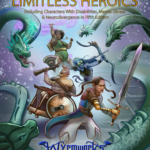Mental

function showRandomTrait() { const traitTable = { 1: 'Animated Hand', "02-04": 'Alleviation Behavior', "05-07": 'Amplified Emotion', 8: 'Anhedonia', "09-11": 'Attention Difference', "12-14": 'Baseless Emotion', "15-16": 'Confusion', "17-18": 'Delusions', 19: 'Depersonalization', 20: 'Derealization', "21-25": 'Diminished Motivation', "26-30": 'Disinhibited Social Engagement', "31-34": 'Eating Disruption', "35-37": 'Emotion Fluctuation', 38: 'Plurality', "39-42": 'Executive Functioning', "43-44": 'Hallucinations', "45-46": 'Intellectual Disability', 47: 'Intrusive Thoughts', "48-59": 'Learning Difference', 60: 'Obsessive Thoughts', 61: 'Personality Difference', "62-78": 'Phobia', "79-83": 'Repetitive Movement', "84-90": 'Startle Amplification', "91-95": 'Stimulus Avoidance', "96-100": 'Traumatic Flashbacks', }; const randomNum = Math.floor(Math.random() * 100) + 1; let trait; for (const key in traitTable) { if (key.includes("-")) { const [start, end] = key.split("-"); if (randomNum >= start && randomNum <= end) { trait = traitTable[key]; break; } } else if (parseInt(key) === randomNum) { trait = traitTable[key]; break; } } document.getElementById("trait").innerHTML = trait; }
| d100 | Trait |
|---|---|
| 01 | Animated Hand |
| 02–04 | Alleviation Behavior |
| 05–07 | Amplified Emotion |
| 08 | Anhedonia |
| 09–11 | Attention Difference |
| 12–14 | Baseless Emotion |
| 15–16 | Confusion |
| 17–18 | Delusions |
| 19 | Depersonalization |
| 20 | Derealization |
| 21–25 | Diminished Motivation |
| 26–30 | Disinhibited Social Engagement |
| 31–34 | Eating Disruption |
| 35–37 | Emotion Fluctuation |
| 38 | Plurality |
| 39–42 | Executive Functioning |
| 43–44 | Hallucinations |
| 45–46 | Intellectual Disability |
| 47 | Intrusive Thoughts |
| 48–59 | Learning Difference |
| 60 | Obsessive Thoughts |
| 61 | Personality Difference |
| 62–78 | Phobia |
| 79–83 | Repetitive Movement |
| 84–90 | Startle Amplification |
| 91–95 | Stimulus Avoidance |
| 96–100 | Traumatic Flashbacks |
A Note about Mental Health Mechanics
As with all rules in this compendium, these game mechanics are simply suggestions to begin the discussion on how to safely include these in your games. Mental health issues are complex and diverse, so the distinction between neurological traits and mental traits in this book is artificial and purely for game design. We've included these mechanics for the sake of representation and education, but everyone’s experience is different, so the player and game master should start with the rules for any given trait as suggestions, and then discuss how they would like to portray these traits at their table — collaboration is key to safe play. Even though this is a book of game mechanics, “I want to roleplay the trait without modifiers or other rules” is a valid way to play these traits.
Some traits also include a path to recovery. If a trait does not include such a path in its entry, that doesn’t mean recovery is impossible — you may find inspiration from the assistive options listed under each entry to play a recovery narrative in your game. Note that recovery is an often-complicated process that cannot be adequately portrayed through a few dice rolls, and the recovery mechanics are given here to communicate hope to those affected by these experiences.
Missing from nearly all of these descriptions is one of the most effective assistive options: a qualified therapist. We didn’t include that in this book due to the complexity of the therapy process, but note the suggestions throughout this section if one of these affects you in real life. We want everyone to get the help they need to fight the monsters in their lives. The Geek Therapeutics network may be a good match for many of our readers, depending on your location, insurance, and specific needs. Otherwise, check your local listings for providers.